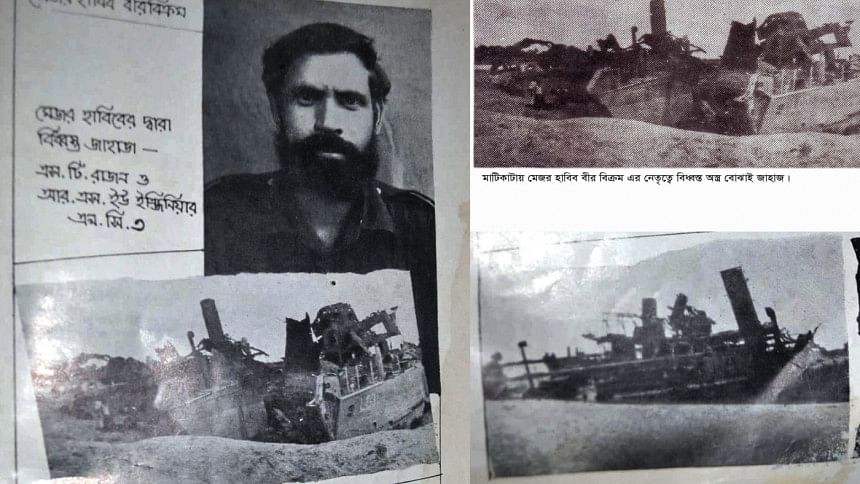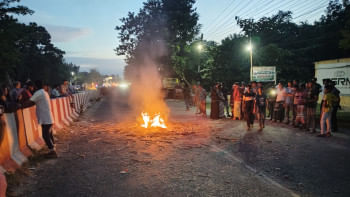Operation Jahajmara: A turning point in the Liberation War history

Freedom fighters of Kaderia Bahini, led by Major Habibur Rahman, destroyed two Pakistani warships near the confluence of Jamuna and Dhaleswari rivers at Sirajkandi in Bhuiyanpur on August 10, 1971.
They also seized a huge amount of arms and ammunition from the enemy vessels before destroying those.
The war is known as 'Jahajmara Juddhya' in the history.
Nowhere else in the long nine-month bloody war have the Pakistani occupational forces suffered such a great loss by the freedom fighters.
This operation is considered as a turning point in the history of the liberation war of Bangladesh.
Abdul Kader Siddique, chief of the then Kaderia Bahini, wrote in his book Swadhinata' 71 that on August 3, the Pakistanis started loading seven ships with arms, ammunitions, foods, fuel and medicines. The 600 prisoners (Bangali EPR members) were engaged by the Pakistanis to do the job of loading the ships at Sadar Ghat in Dhaka.
Golam Mostofa, a man from Chattogram and a Bangali Sareng of S.U Engineers L.C-3, largest of the seven ships, sent a letter to Kaderia Bahini through others saying that the ships will move to Fulchhori River ghat in Bogura. Mostofa also informed in his letter that if the FFs launched attack on the ships, he would help them by hitting the ship on char or set fire to it.
Being informed, an urgent message was immediately sent from the headquarters of Kaderia Bahini to its area commander Major Habibur Rahman (now late) for keeping the river way under their strict watch.
On August 7, 1971, the fleet of the seven ships of the Pakistani forces started its journey and anchored at the bank of the Dhaleswari river at Sirajkandi in Tangail's Bhuiyanpur on August 9. Of the ships, two were large and covered with tarpaulin.
Being informed, Major Habib along with two fellow FFs went near the ships in guise of fishermen for collecting information.
Then several Pakistani soldiers come to them with a speed boat. They asked Major Habib and others if goats, chicken and chamcham (sweets) were available in the area. They told them that they can collect these from the area.
Major Habib and others returned from there and later sent few local informers there to collect more information about the Pakistanis and the ships. They later informed that the ships are full of weapons.
Then Major Habib being worried over the small number FFs and arms in his group sought support from the sub-headquarters of Kaderia Bahini in Bhuiyanpur. However, the sub-headquarters directed Habib that the chief commander had ordered to launch attack on the ships.
On August 10, freedom fighter Rezaul Karim, also a student of Rajshahi University then, along with a group of FFs came to Bhuiyanpur.
Then Major Habib started taking preparation of attack on the ships and directed the FFs for taking ambush at different strategic points on the river bank in Matikata area, some north from Sirajkandi where the Pakistani ships anchored.
At 9:00am on August 11, a volunteer came to Major Habib and informed that the Pakistani ships started moving to north (Sirajganj).
Commander Habib then directed the surrounding FFs on north and south to keep patience and not to open fire before he (Habib) started firing. He along with few others then moved to far north and took position between two houses on the river bank.
At 11:00am, the FFs saw the Pakistani ships coming on a row. Locating big chars in the middle of the river, the ships started moving near the bank measuring the water level.
Five small ships passed through the area one after another and the ambushed FFs were awaiting the signal of commander Habib but he was yet to open fire.
Later, the rest two ships--S.U Engineers L.C-3 and ST Rajan---came close and few Pakistani soldiers were seen taking positions on the decks with machineguns.
This time, the LMG (light machine gun) of Major Habib started firing on the ships and then the others followed. Although, the firing from several Chinese and British LMGs and Rifles by Habib and others could not cause much damage to the Pakistanis, the firing with mortars by Rezaul and rocket launchers by Manju disarrayed the position of the Pakistani troops inside the ships.
The ships later got stuck on near sandy char and the Pakistani soldiers fled to Sirajganj.
On the other hand, the five other ships sailed far away in quick speed rather than coming back for helping the two attacked ships.
Meantime, Bangali Sareg Golam and one other jumped from the ship and Commander Habib directed the FFs to rescue them.
Sareng Mostofa requested the FFs to unload the arms and ammunitions from the ships quickly because the Pakistanis had already sought help to the forces deployed on other places through radio during the attack. He also informed that the huge consignment of arms, ammunitions, fuel, food and medicine was supposed to go to Rangpur and Syedpur cantonments through Fulchhori in Bogura.
Freedom Fighter Samad Gama, a man from Sarishabari in Jamalpur, who took part in the war, told The Daily Star that after getting direction from Commander Habib, he along with his fellows --Jia and Jamshed and Sareng Mostofa-- went to the S.U Engineers L.C-3 ship by a boat.
"We saw bodies of fourteen to fifteen Pakistani soldiers lying in and outside the ship and the ship was full of arms and ammunitions," Samad said.
"After half an hour, the FFs along with several hundred villagers started unloading the weapons from the ship under the supervision of Commander Habib and carried those to safer places with boats," he said.
Although the FFs could able to unload a small part of the arms and ammunition from the ships, these were below:
1. Chinese 3 inches morter shell: 1 lakh 20 thousands.
2. Chinese 2.5 inches morter shell: 10 thousands
3. British 2 inches morter shell: 40 thousands.
4. 82 blander sight shell: 60 thousands.
5. 72 RR shell: 12 thousands.
6. 6 pounds shell: 7 thousands.
7. 120mm shell: 5 thousands boxes.
8. Chinese rifles: 5 hundred.
9. 303 rifles: 1 hundred.
10. 36 hand grenade: 70 thousands.
11. Smock grenade: 10 thousands.
12. Chinese machineguns: 2
13. Chinese 7.62 bullets: 10 lakhs.
14. Chinese 7.65 bullets: 2 lakhs.
15. 303 bullets: 1 lakh.
16. Chinese machine gun's bullets: 5 thousands.
"The other ship (ST Rajan) was loaded with 1 lakh 60 thousand gallons of diesel. Later, we with the help of Sareng Mostofa, set fire to both the ships at 10:00pm," Samad said.
Abdul Alim, a man from Shialkhol in Bhuiyanpur and a FF of Kaderia Bahini, said he along with Anayet Karim, commander of northern region, Bulbul Khan Mahbub and few others were staying at the Dak Bungalow in Bhuiyanpur on August 11. After getting information of destroying the Pakistani ships, they immediately rushed on the spot.
Later, the FFs in supervision of Anayet Karim and Abdul Hamid Bhola took the arms to a local school with boats. Later, these were sent to different safer places, he said.
Being informed, Chief of Kaderia Bahini Abdul Kader Siddique along with other FFs came at Falda in Bhuiyanpur on August 12.
On the other hand, to recover the ships and weapons, the Pakistani forces led by General Amir Abudullah Khan Niazi, commander 47 Brigade, and Brigedier Kader Khan, commander of 51 Commando Bridge, two F-7 Saber Jets and also about 20 gunboats attacked Bhuiyanpur from all ways on the same day.
The FFs tried to resist the Pakistanis till August 13 and also blew up few bridges to stop them from coming in Bhuiyanpur by road. But they could not sustain the defence for long in face of the massive attack by the Pakistanis. The FFs later left the area as per their 'Hit and run strategy', Alim said.
After independence, Commander Major Habibur Rahman was honoured by the government with titles of 'Jahajmara Habib' and 'Bir Bikram' for his far sight, bravery and heroism for winning the game changing war.

 For all latest news, follow The Daily Star's Google News channel.
For all latest news, follow The Daily Star's Google News channel. 



Comments